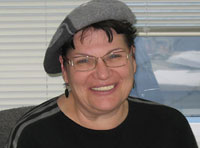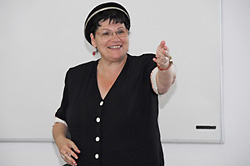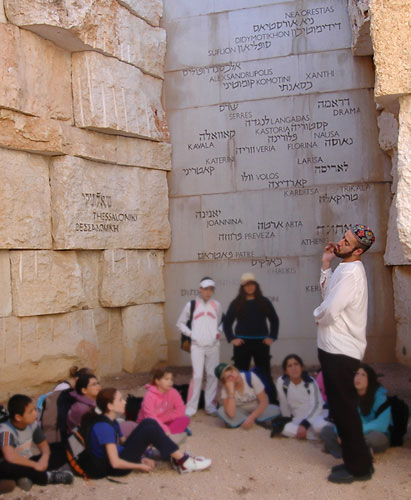"Dear Yad Vashem Teachers,
My name is Gal.* I am seven years old. I have a question: Why did the Holocaust happen? Please send me written material and pictures. Thank you very much."
This touching letter was received by the International School for Holocaust Studies last May. Though simple in words, it raises many complex questions: How should we answer Gal? Where do we start? What can we tell her and what should we avoid? Which pictures should we send her? What should our educational goals be in responding to her letter? At the same time, the letter itself embodies the answer to another question entirely: Should the Holocaust be taught to young children at all?
- *. Name changed to protect identity.
Introduction

Shulamit Imber, 2007
"Teachers must confront the educational and ethical challenges posed by children's awareness of the Holocaust"
As Pedagogical Director, can you explain the approach of the International School of Holocaust Studies regarding this challenging issue?
The Holocaust is part of our identity and collective memory. Every year – especially in Israel, but also abroad – pupils are exposed to the subject through Holocaust Remembrance Day events. From a young age, pupils hear about the Holocaust in various contexts, and they watch programs and films commemorating Holocaust Remembrance Day, most of which are not suited to their cognitive or emotional level.
Although it is understandable to wish to shelter children from this frightening topic, a delay in starting Holocaust education could also lead to children forming an inaccurate impression of the concepts they hear about. Teachers must confront the educational and ethical challenges posed by children's awareness of the Holocaust.
So, how should young children be taught about the Holocaust?
The Holocaust should be taught in a spiral, modular format which expands according to age. At a very young age, the topic is presented in terms of individual experiences, supplemented by discussions of certain basic concepts in a limited and controlled way, without revealing to them all the events and atrocities that occurred. Pupils should be taught by a familiar teacher, or by an adult with whom they have a trusting relationship. This individual is a source of security for them while being exposed to this troubling subject. The younger the child, the more appropriate it is to present him or her with a personal story that has a positive dimension to it – a rescue story or one about a Righteous Among the Nations.
For older children, in order to broaden their understanding of the real variety of fates for Jews during the Holocaust, we talk about the family. Concentrating on the family enables us to touch on the main framework with which children are familiar and for which they are able to develop empathy. At this stage, we can also begin raising basic issues understandable to children, based in their world and family experience. Their knowledge of the day-to-day challenges faced by Jews during the Holocaust is expanded, with attention to various ways of coping with crisis situations.
Over the years, the School has developed several educational programs
Can you tell us about the School's curricula and teacher training for the elementary grades?
Over the years, the School has developed several educational programs suitable for this age group, like Tommy and I Wanted to Fly Like a Butterfly, which draws children into the world of a Jewish girl who tenaciously clung to life amid a harsh reality of destruction and loss, eventually finding her way to Israel and building a new life.
The School also has a new course for Israeli elementary school teachers, training them to incorporate Holocaust education in an age-appropriate way into school curricula and activities.
What about the Internet?
A mini-website was recently launched jointly by the School and Snunit (Internet-based learning) called Children in the Ghetto. Written by and for children, the site describes life during the Holocaust from the perspective of children living in a ghetto, and tries to present the complex experience of ghetto life in a way accessible to children today. The site centers on an imaginary ghetto street that forms the background for various original exhibits such as video testimonies, photographs, artifacts, and drawings. Each exhibit is accompanied by thought-provoking interactive activities.
The School's website also has a lesson plan for third- and fourth-grade teachers using the book I Wanted to Fly Like a Butterfly, which includes suggestions for guided reading, class discussion, and creative work.
And finally, can you explain how young children are taught about the Holocaust at Yad Vashem itself?
The School offers a wide range of activities for fifth- and sixth-graders at Yad Vashem, as well as the "Memories in a Box" mobile educational unit that goes directly to the schools in Israel. Yad Vashem's educational program familiarizes pupils with the world of Jewish children before and during the Holocaust by means of hands-on activities that make use of visual and tactile media. Thus, for example, on a tour of the Valley of the Communities, pupils encounter "Mottl the Fool" and "Jokha the Salonican" through the mediation of a professional actor. Students also tour the web site in a special project based on the stories of Uri Orlev; they view artistic creations and process their experience via creative activities such as art and drama.
This interview was published in the quarterly magazine Yad Vashem Jerusalem (Vol. 42, Summer 2006).








